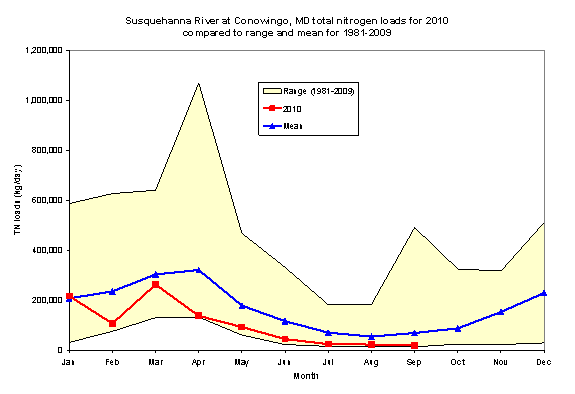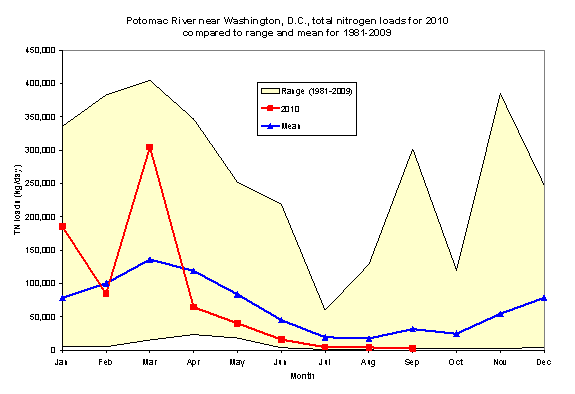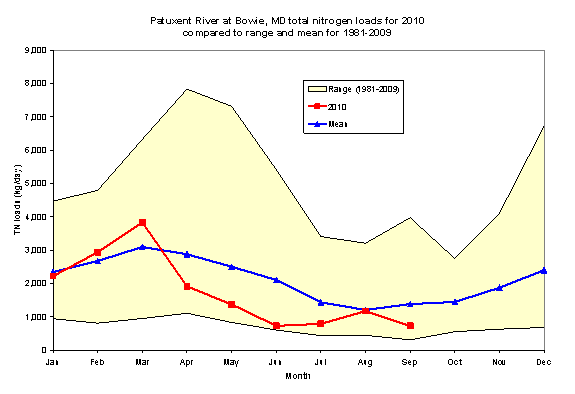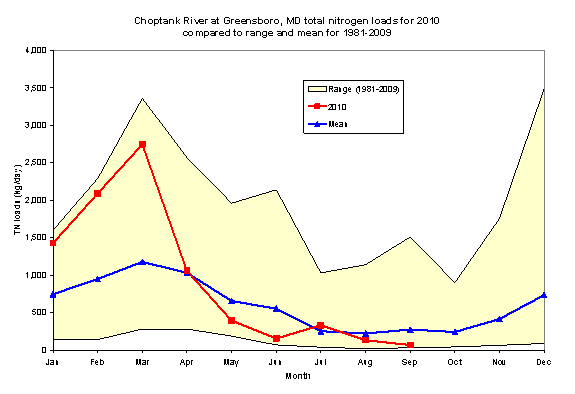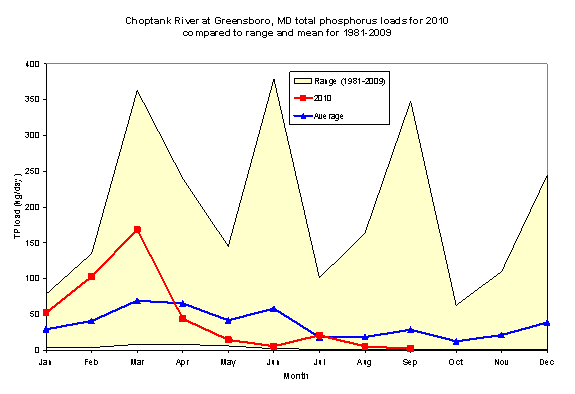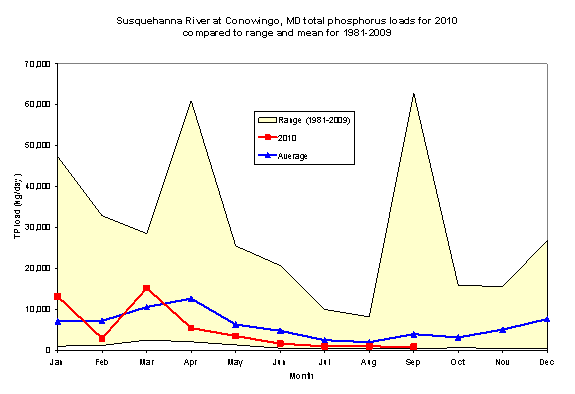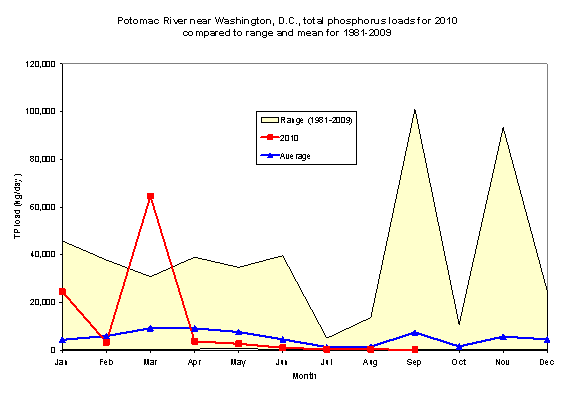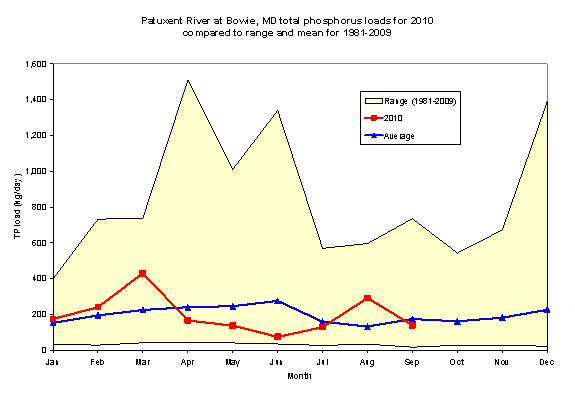 Print This Page
Print This Page Print This Page
Print This Page |
Maryland's Summer 2010 Bay Story
Hot, dry summer may impact some Bay species
Annapolis , Maryland ( December 17, 2010 )
The waters of the Chesapeake Bay and some of its aquatic inhabitants were locally affected by high temperatures and drought conditions during summer 2010. While these impacts will not persist, some Bay inhabitants, such as bay grasses, which provide crucial food and habitat for many bay species, could show long-term consequences. Other Bay inhabitants, such as fish, crabs and oysters will show little, if any long-term impact.
There is no such thing as an average year or average conditions for the Chesapeake Bay . Wet or dry, cold or warm, each year brings a unique set of weather conditions to which the Bay adapts. The large size of the Bay and its watershed contribute to the complex responses we see. This past year has been no different.

Figure 1 - Flow into Maryland 's portion of the Bay
The wet spring sent a pulse of polluted runoff (See graphs of nitrogen and phosphorus loads) into the Bay from some rivers and, with warm conditions causing algae to thrive and resulted in reduced dissolved oxygen (DO) levels in the water. The low DO levels reduce the available habitat for crabs, oysters and fish and other Bay species.
“While we can't control the weather, we can work to control and track progress of the amount of polluted runoff reaching the Bay,” said Governor Martin O'Malley. “That is why Maryland and the other Bay states are aggressively working to reduce nutrient pollution with two-year milestones to help guide our efforts to restore the health of our Chesapeake Bay .”
Many Marylanders will remember 2010 for its cold and snowy winter, its incredibly wet spring, and a seemingly endless barrage of sweltering summer days. In fact, Maryland set several records for extreme weather in 2010:
How do these extremes in weather impact Maryland 's portion of the Bay? To find out, let's examine the Maryland Department of Natural Resources (DNR) Bay monitoring data collected since 1984 (see “Eyes on the Bay” website for data and more information). This comprehensive program is designed to track progress of the Bay cleanup, evaluate the causes of Bay degradation and better understand Maryland 's waters.
Q. Did the warmer than average summer air temperatures in 2010 affect the temperature of the Bay?
Q. Did high water temperatures in 2010 result in lower than average dissolved oxygen concentrations?
Q. Did rainfall levels affect salinity in the Bay?
Q. Did high spring rain and snowfall levels affect water clarity in the Bay?
Q. Did high temperatures in 2010 affect the amount of bay grasses in the Bay?
Q. Did high temperature levels in 2010 affect algal blooms in the Bay?
Q. What is Maryland doing to restore the Chesapeake Bay?
Back to Frequently Asked Questions
Q. Did the warmer than average summer air temperatures in 2010 affect the temperature of the Bay?
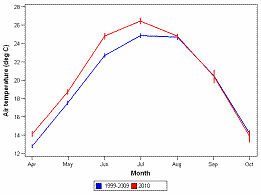
Figure 2 - Bay area summer air temperatures
*Air temperature data from NOAA's National Climate Data Center using
all Maryland divisions except the Allegany Plateau and Appalachian Mountains :
A. Yes! While spring water temperatures in deeper portions of the Bay were cooler than average as a result of the very cold winter, summer water temperatures were warmer than the long-term average (1999-2009) during the summer. At about 50 percent of the long-term monitoring stations, June water temperatures set long-term records (Figure 3).
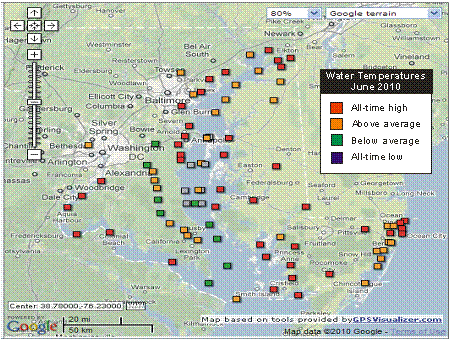
Figure 3 - Chesapeake Bay water temperatures
Several of DNR 's shallow water monitoring sites had extremely high surface water temperatures. As air temperatures peaked between mid-June and the end of August, Corsica River water temperatures reached and sometimes exceeded 90 degrees F. At the Otter Point Creek station on the Bush River surface water temperatures in excess of 90 degrees F were recorded even more frequently with a record peak temperature of 96 degrees F on July 24 (Figure 4). High water temperatures can impact fish and other Bay species by reducing the amount of oxygen available in the water and can be stressful to the growth of underwater grasses and other aquatic life in shallow waters.
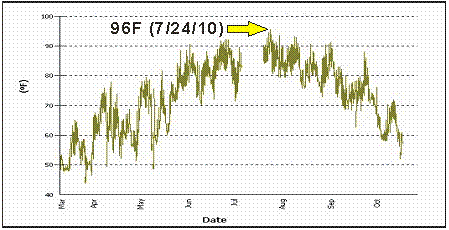
Figure 4 - Bush River (Otter Point Creek) water temperatures
Back to Frequently Asked Questions
Q. Did high water temperatures in 2010 result in lower than average dissolved oxygen concentrations?
A. Yes! Dissolved oxygen (DO) was lower than average in most areas of the Bay in most months of 2010. This is a critical measurement as low oxygen is a key indicator of poor water quality. Most fish, crabs, and oysters need 5 mg/L of DO for growth and reproduction. Because warmer water holds less dissolved oxygen than colder water, summer DO levels are usually the lowest from early June through August. By September, dissolved oxygen levels are increasing, as Bay waters begin to cool and are better mixed than during the summer.
Algae blooms can also impact DO. Although algae blooms eventually lead to a drop in DO. During the beginning stages of the algal bloom, the DO in surrounding waters increase as more algae, makes more oxygen. When the bloom ends and the algae die and sink into deeper waters, bacteria that decompose these plant cells consume oxygen, reducing the DO levels in the deeper portions of the Bay. This process can lower DO so much that fish and crabs may suffocate.
Dissolved Oxygen Facts: In 2010:
• Heavy spring rains and snowmelt led to unusually low DO levels in March and April in some Maryland tidal tributaries. One station on the Magothy River recorded a DO level of 0.8 milligrams per liter (mg/L), while a site on the Corsica River recorded several DO readings that approached 0 mg/L. These seasonally low oxygen levels continued into April, as half of the monthly monitoring stations recorded DO measurements of less than 5mg/l.
• DO at the continuous monitoring site located just north of the Bay Bridge was less than 1mg/L between June 1 and August 20 indicating “dead zone” conditions.
• The largest decline in dissolved oxygen from average Bay conditions was in the Mid-Bay region in July 2010.
• In the Patuxent River (July and August 2010) and in the Potomac River (June 2010), dissolved oxygen levels were higher than average along with water temperatures. These higher DO levels may have resulted from local algae blooms.
• DO concentrations were below the long-term average (1985-2009) at main Bay stations several times between March and September. Record low dissolved oxygen concentrations were observed in the month of April at several main Bay stations.
Upper Bay- (Susquehanna Flats to Patapsco River ) Mid Bay – ( Patapsco River to Little Choptank River )

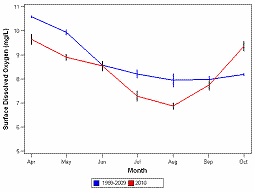
Lower Bay – (Little Choptank to MD/VA line) Patuxent
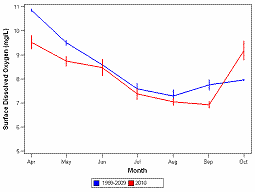
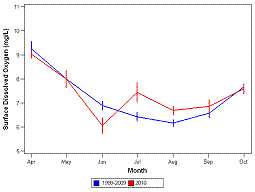
Potomac All other Maryland tributaries
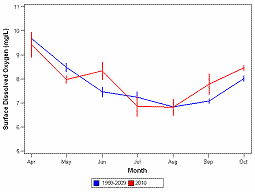
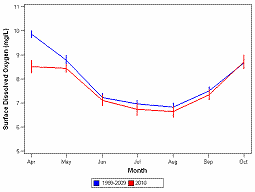
Figure 5: Monthly average surface dissolved oxygen by region. Error bars represent ± std. err. of mean.
• There was more low oxygen water than average for the Maryland portion of the main Bay in summer 2010 (June, July, and August). This was the ninth worst on record for July and the third worst on record for late August. By September, DO levels were better than the long-term average for the month (Figure 6).
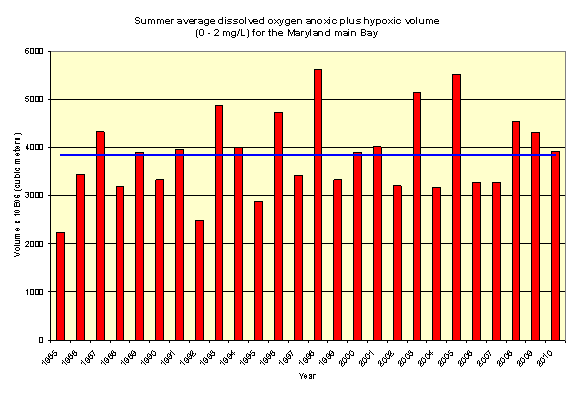
Figure 6 - Amount of low DO in MD's waters in 2010. Blue line indicates long-term average low DO conditions.
Back to Frequently Asked Questions
Q. Did rainfall levels affect salinity in the Bay?
A. Yes! Salinity is the amount of salt in the water. It can change due to dilution or evaporation and in the Bay because of mixing of the saltier ocean water with freshwater rivers and streams. Salinity was generally higher than average in 2010. In July and August 2010, salinity was higher than average in the Mid- and Lower-Bay regions because of low streamflow into the Bay. However, most Bay inhabitants are capable of adapting to these normal fluctuations in salinity.
Upper Bay- (Susquehanna Flats to Patapsco River ) Mid Bay – ( Patapsco River to Little Choptank River )
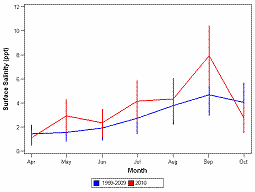

Lower Bay – (Little Choptank to MD/VA line) Patuxent


Potomac All other Maryland tributaries

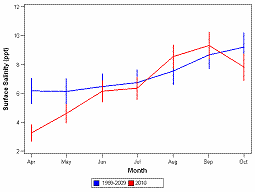
Figure 7: Monthly average surface salinity by region. Error bars represent ± std. err. of mean.
Back to Frequently Asked Questions
Q. Did high spring rain and snowfall levels affect water clarity in the Bay?
A. No! Despite high levels of snow and rain in some regions of the Bay watershed during the winter and spring of 2010, water clarity most times was within the expected seasonal range. In the tributaries, June and July 2010 water clarity (depth Secchi disc disappears) was much lower than the average.
High levels of precipitation often lead to lower water clarity in the Bay and its tributaries because water running toward the Bay accumulates sediments and nutrients along the way. Sediment may stay suspended in the water column for long periods and excess nutrients lead to algae blooms that reduce clarity. Adequate water clarity is essential to allow light to reach bay grasses, important for providing food and shelter for many Bay species.
Upper Bay- (Susquehanna Flats to Patapsco River ) Mid Bay – ( Patapsco River to Little Choptank River )
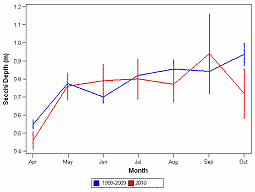

Lower Bay – (Little Choptank to MD/VA line) Patuxent

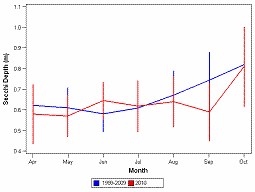
Potomac All other Maryland tributaries

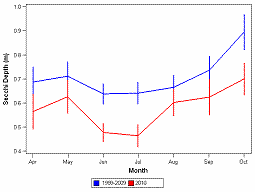
Figure 8: Monthly average Secchi depth by region. Error bars represent ± std. err. of mean
Back to Frequently Asked Questions
Q. Did high temperatures in 2010 affect the amount of bay grasses in the Bay?
A. Yes and No! The warm summer temperatures experienced during the 2010 summer were a mixed blessing for Maryland 's bay grasses. Also known as submerged aquatic vegetation (SAV), bay grasses are critical to the Chesapeake Bay because they provide food and shelter for a wide range of fish, shellfish and waterfowl including largemouth bass, blue crabs and the canvasback duck. Healthy bay grass beds also protect shorelines from wave erosion, produce oxygen, and filter polluted water. Because bay grasses are sensitive to minor changes in water quality, they serve as a key indicator of the Chesapeake Bay health.
Eelgrass , found in the saltier southern regions of Maryland 's waters, suffered a seasonal die-back this summer due to the above average June water temperatures. The extent of this die-back won't be apparent until the 2011 aerial bay grass survey is completed. In the middle regions of Maryland's Chesapeake Bay, widgeon grass appear to have declined since 2009, but it is not know if this is a result of higher summer water temperatures. In the Upper Bay and freshwater portions of Maryland's waters, many bay grass species have done very well, with populations equal to or greater than the those observed in 2009. Freshwater bay grass species thrive in warmer water, and their expansion of the last several years is continuing.
Back to Frequently Asked Questions
Q. Did high temperature levels in 2010 affect algal blooms in the Bay?
A. In some areas, yes! Significant blue-green algae blooms were observed in the tidal fresh Bay tributaries and several lakes during the summer of 2010 following long periods of higher than normal temperatures. Between April and August 2010, water quality mapping showed some extensive algae blooms occurred in the upper Chesapeake Bay and Patapsco River . The Patapsco River was impacted by a severe algae bloom in April, affecting most of the river. Blooms were present in the upper river through June and July, with some low dissolved oxygen in the Inner Harbor . However, in the Chesapeake Bay just outside the mouth of the Patapsco, severe algae blooms were present only in April. This differed from 2009, when severe blooms were present throughout this area during most of the months sampled. The Corsica River suffered from severe algal blooms during April-October 2010, mostly in the upper two-thirds of the river - a pattern similar to what was seen in 2009. In contrast, the Honga River displayed no extreme algal activity during either the 2009 or 2010 cruises.
In terms of potentially harmful algae, blooms of Microcystis , a species of blue green algae, routinely occur during late summer and is associated in warm, nutrient enriched fresh waters. These blooms can produce a toxin that may damage the liver and cause gastrointestinal discomfort when ingested and minor skin rashes upon contact. Water contact advisories were posted in a number of fresh water ponds around the State, and in the Transquaking River . Microcystis was present on the Sassafras River , but no toxin was documented; however, other non-toxic bluegreen algae did bloom this year in the Sassafras River and contribute to low oxygen levels downstream.
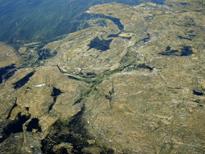
Figure 9 – Algal mat on the Susquehanna Flats 9/1/2010
Blooms of Lyngbya , a stringy blue-green alga that routinely plagues many Florida waters, were prevalent on the upper Chesapeake Bay since May clogging commercial fishing gear such as pound nets and crab pots. Later in the summer, Lyngbya was found in some Potomac River tributaries including Piscataway and Mattawoman Creeks. Warmer late spring temperatures may have been a key factor in the development of this bloom. In addition, large blooms of Oscillatoria , another blue-green alga, were observed on the upper tidal Potomac River .
Back to Frequently Asked Questions
Q. What is Maryland doing to restore the Chesapeake Bay?
“The waters of the Chesapeake Bay are important to Marylanders for many reasons, whether you fish, boat or swim in its waters, or simply enjoy its world-class seafood. We know that the best way to restore the health of the Chesapeake Bay is by nutrient and sediment reduction. Our actions, collectively or individually, are imperative if we are to provide a clean and healthy Chesapeake Bay for all Maryland citizens, young and old,” said DNR Secretary John R. Griffin.
To help accomplish the goal of restoring the Bay, Governor Martin O'Malley is taking aggressive actions to reduce polluted runoff from the major Bay sources. Maryland has just submitted its Watershed Implementation Plan, developed by the Maryland Departments of the Environment, Natural Resources, Agriculture, and Planning, using the State's BayStat process, to comply with the new EPA Chesapeake Bay Total Daily Maximum Load (TMDL) requirements due by the end of this year.
The plan identifies 75 strategy options to reduce polluted runoff from the sewage treatment plants, developed lands, septic systems, farms and the air. Actions to clean up Maryland's waterways will also have an economic benefit; upgrading wastewater treatment plants, retrofitting septic or stormwater management systems, installing “living” shorelines or planting cover crops are a few examples of projects in the plan that would maintain or create jobs. Citizens can also take actions to clean up the Bay, including maintaining your septic system, sensible lawn care and planting trees and shrubs.
Back to Frequently Asked Questions
For More Information
• Eyes on the Bay's Real-time Maryland Tidal Water Quality Conditions
• Bay Grasses: identification, importance and status
• VIMS Annual Bay Grass Survey
• Maryland DNR Algae bloom information
• What You Can Do to Help the Bay
